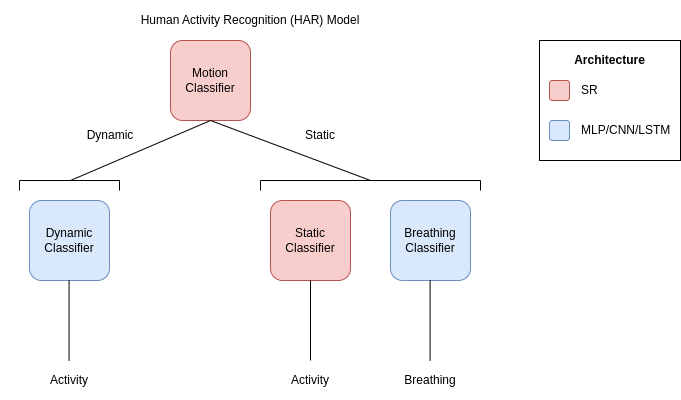IMU Activity Data: https://github.com/specknet/pdiot-data
SR - Softmax Regression
MLP - Multilayer Perceptron
CNN - Convolutional Neural Network
LSTM - Long Short-Term Memory
Only use data collected during normal breathing!
class 0: sitting/standing
class 1: lying down on your left side
class 2: lying down on your right side
class 3: lying down on your back
class 4: lying down on your stomach
class 5: walking
class 6: running/jogging
class 7: descending stairs
class 8: ascending stairs
class 9: shuffle walking
class 10: miscellaneous movements
Do not include any data files/recordings that contain laughing, singing, eating, or talking!
class 0: sitting/standing + breathing normally
class 1: lying down on your left side + breathing normally
class 2: lying down on your right side + breathing normally
class 3: lying down on your back + breathing normally
class 4: lying down on your stomach + breathing normally
class 5: sitting/standing + coughing
class 6: lying down on your left side + coughing
class 7: lying down on your right side + coughing
class 8: lying down on your back + coughing
class 9: lying down on your stomach + coughing
class 10: sitting/standing + hyperventilating
class 11: lying down on your left side + hyperventilating
class 12: lying down on your right side + hyperventilating
class 13: lying down on your back + hyperventilating
class 14: lying down on your stomach + hyperventilating
class 0: sitting/standing + breathing normally
class 1: lying down on your left side + breathing normally
class 2: lying down on your right side + breathing normally
class 3: lying down on your back + breathing normally
class 4: lying down on your stomach + breathing normally
class 5: sitting/standing + coughing
class 6: lying down on your left side + coughing
class 7: lying down on your right side + coughing
class 8: lying down on your back + coughing
class 9: lying down on your stomach + coughing
class 10: sitting/standing + hyperventilating
class 11: lying down on your left side + hyperventilating
class 12: lying down on your right side + hyperventilating
class 13: lying down on your back + hyperventilating
class 14: lying down on your stomach + hyperventilating
class 15: sitting/standing + other
class 16: lying down on your left side + other
class 17: lying down on your right side + other
class 18: lying down on your back + other
class 19: lying down on your stomach + other
**other refers to singing/talking/laughing/eating
# python (change to desired version)
conda create -n <env_name> python=3.10.13
conda activate <env_name>
# tensorflow (change to desired version)
conda install tensorflow==2.11.0
# data processing
conda install numpy pandas scikit-learn tqdm
# config, logging (not on conda)
pip install yacs wandb --upgrade-strategy only-if-needed
# for fully functionality
cd <imu-har_directory>
python setup.py install
- Format activity classification dataset for your component. Example scripts found in
data.
Custom dataset files are expected to be formatted as follows:
{ 'filepath': <data_csv_filepath>,
'subject': <subject_id>,
'annotation': <class>,
'labels': [ <motion_label>,
<dynamic_label>,
<static_label>
<breath_label> ]
}
...
The number of labels will vary based on the model components required for the task (Structure). Training does not use the annotation, but the label corresponding to the model component being trained.
- Make configuration YAML file.
Example dynamic.yaml:
DATASET:
task: 1
component: 'dynamic'
MODEL:
ARCH:
CNN:
kernel_size: 5
pool_size: 2
dropout: 0.5
hidden_size: 64
num_layers: 2
LSTM:
dropout: 0.5
hidden_size: 64
num_layers: 1
MLP:
dropout: 0.0
hidden_size: 64
num_layers: 1
INPUT:
format: window
sensor: accel
fft: True
- Run the training
python train.py -c <config_dirpath> -i <odgt_dirpath> -o <checkpoint_dirpath> -t <task> -p <component>
- Results are stored at the checkpoint directory. By default your directory will be set up as follows:
<DIR>
├── weights.hdf5 # checkpoint with best validation accuracy
├── history.csv # training and validation metrics history
├── config.yaml # configuration file (updated with train.py arguments)
└── log.txt # model training logs
- Format activity classification dataset for your test task. Example scripts found in
data.
Custom dataset files are expected to be formatted as follows:
{ 'filepath': <data_csv_filepath>,
'subject': <subject_id>,
'annotation': <class>,
'labels': [ <motion_label>,
<dynamic_label>,
<static_label>
<breath_label> ]
}
...
The number of labels will vary based on the model components required for the task (Structure).
- Make configuration YAML file.
Example task_1.yaml:
DATASET:
task: 1
MODEL:
CONFIG:
motion: motion.yaml
dynamic: dynamic.yaml
static: static.yaml
INPUT:
window_size: 50
TEST:
DATA:
overlap_size: 40
batch_size: 128
- Run the LOO testing for a given
subject. This means we train the HAR model on the data from all the other subjects, and evaluate on the data from the specified subject.
python test.py -c <config_dirpath> -i <test_odgt_dirpath> -o <output_dirpath> -t <task> -s <subject>
- Results are stored at the checkpoint directory. By default your directory will be set up as follows:
<DIR>
├── result.csv # LOO predictions and actual labels
├── config.yaml # configuration file (updated with test.py arguments)
└── log.txt # LOO test logs


